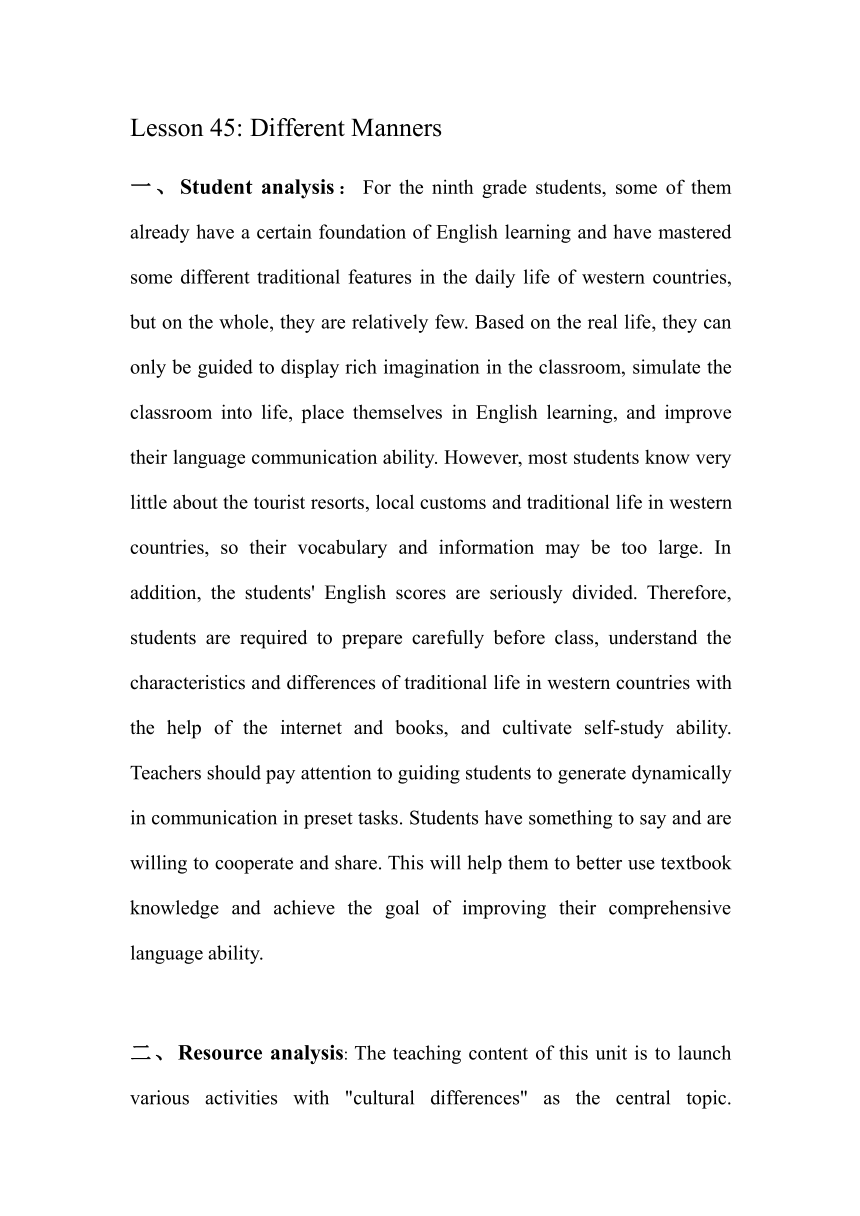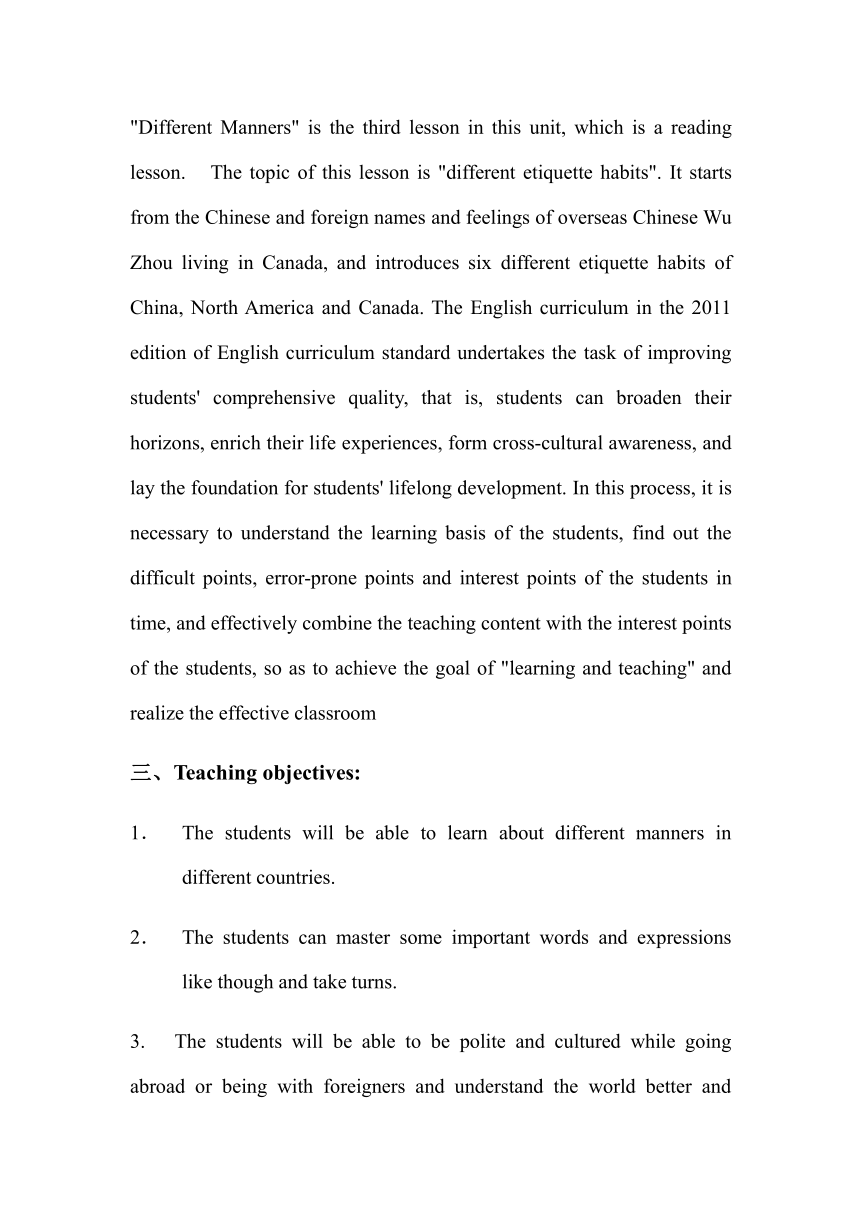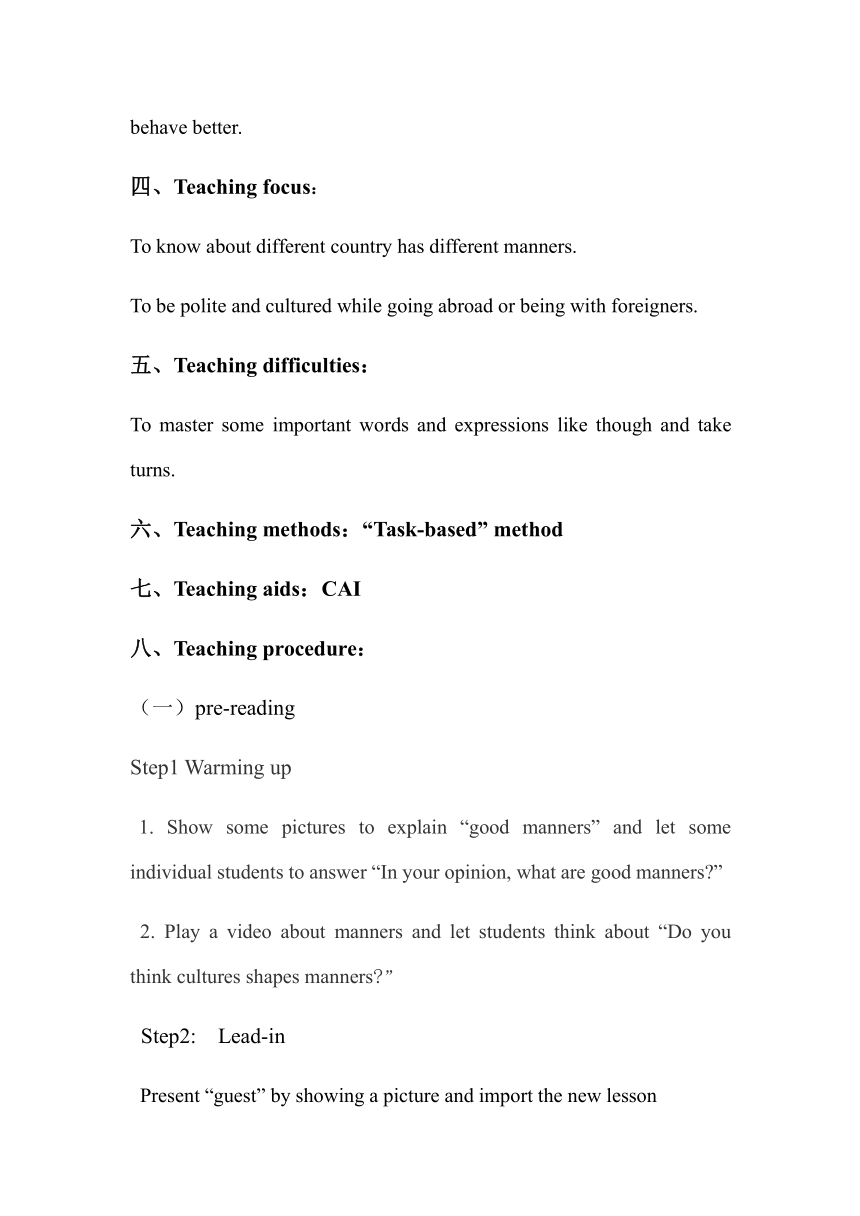冀教版英语九年级全一册 Unit 8 Culture Shapes Us Lesson 45 Different Manners 教案
文档属性
| 名称 | 冀教版英语九年级全一册 Unit 8 Culture Shapes Us Lesson 45 Different Manners 教案 |  | |
| 格式 | zip | ||
| 文件大小 | 29.0KB | ||
| 资源类型 | 教案 | ||
| 版本资源 | 冀教版 | ||
| 科目 | 英语 | ||
| 更新时间 | 2020-05-28 17:30:59 | ||
图片预览



文档简介
Lesson
45:
Different
Manners
一、Student
analysis:For
the
ninth
grade
students,
some
of
them
already
have
a
certain
foundation
of
English
learning
and
have
mastered
some
different
traditional
features
in
the
daily
life
of
western
countries,
but
on
the
whole,
they
are
relatively
few.
Based
on
the
real
life,
they
can
only
be
guided
to
display
rich
imagination
in
the
classroom,
simulate
the
classroom
into
life,
place
themselves
in
English
learning,
and
improve
their
language
communication
ability.
However,
most
students
know
very
little
about
the
tourist
resorts,
local
customs
and
traditional
life
in
western
countries,
so
their
vocabulary
and
information
may
be
too
large.
In
addition,
the
students'
English
scores
are
seriously
divided.
Therefore,
students
are
required
to
prepare
carefully
before
class,
understand
the
characteristics
and
differences
of
traditional
life
in
western
countries
with
the
help
of
the
internet
and
books,
and
cultivate
self-study
ability.
Teachers
should
pay
attention
to
guiding
students
to
generate
dynamically
in
communication
in
preset
tasks.
Students
have
something
to
say
and
are
willing
to
cooperate
and
share.
This
will
help
them
to
better
use
textbook
knowledge
and
achieve
the
goal
of
improving
their
comprehensive
language
ability.
二、Resource
analysis:
The
teaching
content
of
this
unit
is
to
launch
various
activities
with
"cultural
differences"
as
the
central
topic.
"Different
Manners"
is
the
third
lesson
in
this
unit,
which
is
a
reading
lesson.
The
topic
of
this
lesson
is
"different
etiquette
habits".
It
starts
from
the
Chinese
and
foreign
names
and
feelings
of
overseas
Chinese
Wu
Zhou
living
in
Canada,
and
introduces
six
different
etiquette
habits
of
China,
North
America
and
Canada.
The
English
curriculum
in
the
2011
edition
of
English
curriculum
standard
undertakes
the
task
of
improving
students'
comprehensive
quality,
that
is,
students
can
broaden
their
horizons,
enrich
their
life
experiences,
form
cross-cultural
awareness,
and
lay
the
foundation
for
students'
lifelong
development.
In
this
process,
it
is
necessary
to
understand
the
learning
basis
of
the
students,
find
out
the
difficult
points,
error-prone
points
and
interest
points
of
the
students
in
time,
and
effectively
combine
the
teaching
content
with
the
interest
points
of
the
students,
so
as
to
achieve
the
goal
of
"learning
and
teaching"
and
realize
the
effective
classroom
三、Teaching
objectives:
1.
The
students
will
be
able
to
learn
about
different
manners
in
different
countries.
2.
The
students
can
master
some
important
words
and
expressions
like
though
and
take
turns.
3.
The
students
will
be
able
to
be
polite
and
cultured
while
going
abroad
or
being
with
foreigners
and
understand
the
world
better
and
behave
better.
四、Teaching
focus:
To
know
about
different
country
has
different
manners.
To
be
polite
and
cultured
while
going
abroad
or
being
with
foreigners.
五、Teaching
difficulties:
To?master
some
important
words
and
expressions
like
though
and
take
turns.
六、Teaching
methods:“Task-based”
method
七、Teaching
aids:CAI
八、Teaching
procedure:
(一)pre-reading
Step1
Warming
up
1.
Show
some
pictures
to
explain
“good
manners”
and
let
some
individual
students
to
answer
“In
your
opinion,
what
are
good
manners?”
2.
Play
a
video
about
manners
and
let
students
think
about
“Do
you
think
cultures
shapes
manners?”
Step2:
Lead-in
Present
“guest”
by
showing
a
picture
and
import
the
new
lesson
(二)While-reading
Step3:
presentation
Introduce
the
cultural
differences
between
China
and
foreign
countries
through
pictures,
including
being
praised,
asking
about
age,
paying
for
meals,
entertaining
guests,
giving
tips
and
giving
seats
to
the
elderly.
This
leads
to
the
usage
of
"though"
Step4:
Practice
Match
and
complete
the
sentences
and
practice
the
structure:
Adverbial
Clause
with
“though”
Step5:
Listening
Students
listen
to
the
tape
and
fill
the
blanks
Step6:
Skimming
Ask
the
students
to
read
the
text
quickly
and
fill
in
the
blanks.
Then
check
the
answers
Step7:
Scanning
Read
the
text
carefully
and
finish
the
mind
map.
Ask
the
students
to
follow
the
example
given
by
the
teacher
.
Do
it
themselves
and
then
check
the
answers
with
groups
.
(三)After-reading
Step8:
Group
work
Suppose
an
exchange
student
from
Canada
comes
to
our
class,
ask
the
students
to
role
play
about
the
different
manners
in
the
two
countries.
Step9:
Sum-up
(Show
the
PPT)
Give
the
students
some
examples
about
different
manners
in
some
western
countries
like
weeding
manners,
table
manners
and
greeting
manners
and
so
on,
and
summarize
the
main
idea
of
the
passage,
which
helps
them
open
up
their
minds
and
further
understand
the
western
cultures.
Different
cultures
shape
different
manners.
We
should
remember
the
old
saying
:
When
in
Rome,
do
as
Romans
do,
then
we’ll
understand
the
world
better
and
behave
better.
Step10:
Homework
Compare
the
manners
between
China
and
the
country
you
choose
and
write
a
passage
九、Teacher’s
reflection:
In
this
lesson,
all
of
the
students
were
very
hard-working.
It
seemed
that
they
had
grasped
all
the
knowledge
effectively
in
this
period.
However,
I
found
some
problems
when
they
stood
up
to
give
me
answers.
On
the
whole,
the
students
and
I
cooperated
well
during
the
following
steps.
In
my
teaching
process,
I
felt
a
pity
that
I
didn’t
give
the
students
time
to
present
their
papers
and
correct
their
mistake
.I
think
it
would
be
better
for
me
to
improve
the
teaching
procedure
for
future
use.
十、Board
design:
Lesson
45:
Different
Manners
manners
private
guest
take
turns
doing
modest
waiter
virtue
extra
praise
tipping(leave
a
tip)
elderly
though/although
Different
Cultures
In
North
America
Amer
America
In
China
Different
Manners
When
in
Rome,
do
as
Romans
do.
45:
Different
Manners
一、Student
analysis:For
the
ninth
grade
students,
some
of
them
already
have
a
certain
foundation
of
English
learning
and
have
mastered
some
different
traditional
features
in
the
daily
life
of
western
countries,
but
on
the
whole,
they
are
relatively
few.
Based
on
the
real
life,
they
can
only
be
guided
to
display
rich
imagination
in
the
classroom,
simulate
the
classroom
into
life,
place
themselves
in
English
learning,
and
improve
their
language
communication
ability.
However,
most
students
know
very
little
about
the
tourist
resorts,
local
customs
and
traditional
life
in
western
countries,
so
their
vocabulary
and
information
may
be
too
large.
In
addition,
the
students'
English
scores
are
seriously
divided.
Therefore,
students
are
required
to
prepare
carefully
before
class,
understand
the
characteristics
and
differences
of
traditional
life
in
western
countries
with
the
help
of
the
internet
and
books,
and
cultivate
self-study
ability.
Teachers
should
pay
attention
to
guiding
students
to
generate
dynamically
in
communication
in
preset
tasks.
Students
have
something
to
say
and
are
willing
to
cooperate
and
share.
This
will
help
them
to
better
use
textbook
knowledge
and
achieve
the
goal
of
improving
their
comprehensive
language
ability.
二、Resource
analysis:
The
teaching
content
of
this
unit
is
to
launch
various
activities
with
"cultural
differences"
as
the
central
topic.
"Different
Manners"
is
the
third
lesson
in
this
unit,
which
is
a
reading
lesson.
The
topic
of
this
lesson
is
"different
etiquette
habits".
It
starts
from
the
Chinese
and
foreign
names
and
feelings
of
overseas
Chinese
Wu
Zhou
living
in
Canada,
and
introduces
six
different
etiquette
habits
of
China,
North
America
and
Canada.
The
English
curriculum
in
the
2011
edition
of
English
curriculum
standard
undertakes
the
task
of
improving
students'
comprehensive
quality,
that
is,
students
can
broaden
their
horizons,
enrich
their
life
experiences,
form
cross-cultural
awareness,
and
lay
the
foundation
for
students'
lifelong
development.
In
this
process,
it
is
necessary
to
understand
the
learning
basis
of
the
students,
find
out
the
difficult
points,
error-prone
points
and
interest
points
of
the
students
in
time,
and
effectively
combine
the
teaching
content
with
the
interest
points
of
the
students,
so
as
to
achieve
the
goal
of
"learning
and
teaching"
and
realize
the
effective
classroom
三、Teaching
objectives:
1.
The
students
will
be
able
to
learn
about
different
manners
in
different
countries.
2.
The
students
can
master
some
important
words
and
expressions
like
though
and
take
turns.
3.
The
students
will
be
able
to
be
polite
and
cultured
while
going
abroad
or
being
with
foreigners
and
understand
the
world
better
and
behave
better.
四、Teaching
focus:
To
know
about
different
country
has
different
manners.
To
be
polite
and
cultured
while
going
abroad
or
being
with
foreigners.
五、Teaching
difficulties:
To?master
some
important
words
and
expressions
like
though
and
take
turns.
六、Teaching
methods:“Task-based”
method
七、Teaching
aids:CAI
八、Teaching
procedure:
(一)pre-reading
Step1
Warming
up
1.
Show
some
pictures
to
explain
“good
manners”
and
let
some
individual
students
to
answer
“In
your
opinion,
what
are
good
manners?”
2.
Play
a
video
about
manners
and
let
students
think
about
“Do
you
think
cultures
shapes
manners?”
Step2:
Lead-in
Present
“guest”
by
showing
a
picture
and
import
the
new
lesson
(二)While-reading
Step3:
presentation
Introduce
the
cultural
differences
between
China
and
foreign
countries
through
pictures,
including
being
praised,
asking
about
age,
paying
for
meals,
entertaining
guests,
giving
tips
and
giving
seats
to
the
elderly.
This
leads
to
the
usage
of
"though"
Step4:
Practice
Match
and
complete
the
sentences
and
practice
the
structure:
Adverbial
Clause
with
“though”
Step5:
Listening
Students
listen
to
the
tape
and
fill
the
blanks
Step6:
Skimming
Ask
the
students
to
read
the
text
quickly
and
fill
in
the
blanks.
Then
check
the
answers
Step7:
Scanning
Read
the
text
carefully
and
finish
the
mind
map.
Ask
the
students
to
follow
the
example
given
by
the
teacher
.
Do
it
themselves
and
then
check
the
answers
with
groups
.
(三)After-reading
Step8:
Group
work
Suppose
an
exchange
student
from
Canada
comes
to
our
class,
ask
the
students
to
role
play
about
the
different
manners
in
the
two
countries.
Step9:
Sum-up
(Show
the
PPT)
Give
the
students
some
examples
about
different
manners
in
some
western
countries
like
weeding
manners,
table
manners
and
greeting
manners
and
so
on,
and
summarize
the
main
idea
of
the
passage,
which
helps
them
open
up
their
minds
and
further
understand
the
western
cultures.
Different
cultures
shape
different
manners.
We
should
remember
the
old
saying
:
When
in
Rome,
do
as
Romans
do,
then
we’ll
understand
the
world
better
and
behave
better.
Step10:
Homework
Compare
the
manners
between
China
and
the
country
you
choose
and
write
a
passage
九、Teacher’s
reflection:
In
this
lesson,
all
of
the
students
were
very
hard-working.
It
seemed
that
they
had
grasped
all
the
knowledge
effectively
in
this
period.
However,
I
found
some
problems
when
they
stood
up
to
give
me
answers.
On
the
whole,
the
students
and
I
cooperated
well
during
the
following
steps.
In
my
teaching
process,
I
felt
a
pity
that
I
didn’t
give
the
students
time
to
present
their
papers
and
correct
their
mistake
.I
think
it
would
be
better
for
me
to
improve
the
teaching
procedure
for
future
use.
十、Board
design:
Lesson
45:
Different
Manners
manners
private
guest
take
turns
doing
modest
waiter
virtue
extra
praise
tipping(leave
a
tip)
elderly
though/although
Different
Cultures
In
North
America
Amer
America
In
China
Different
Manners
When
in
Rome,
do
as
Romans
do.
同课章节目录
- Unit 7 Work for Peace
- Lesson 37 Don't Fight!
- Lesson 38 Making School a Better Place
- Lesson 39 The Dove and the Olive Branch
- Lesson 40 The UN—Power of Words
- Lesson 41 Jenny's Good Advice
- Lesson 42 Peace at Last
- Unit Review
- Unit 8 Culture Shapes Us
- Lesson 43 A Visit to Chinatown
- Lesson 44 Popular Sayings
- Lesson 45 Different Manners
- Lesson 46 Home to Many Cultures
- Lesson 47 Good Manners
- Lesson 48 Supper with the Bradshaws
- Unit Review
- Unit 9 Communication
- Lesson 49 Get Along with Others
- Lesson 50 Tips for Good Communication
- Lesson 51 What Could Be Wrong?
- Lesson 52 The Power of a Smile
- Lesson 53 Working in Groups
- Lesson 54 How Embarrassing!
- Unit Review
- Unit 10 Get Ready for the Future
- Lesson 55 Look into the Future
- Lesson 56 Manage Your Time
- Lesson 57 Best Wishes
- Lesson 58 Ms.Liu's Speech
- Lesson 59 Keep Your Choices Open
- Lesson 60 Get a Good Education
- Unit Review
